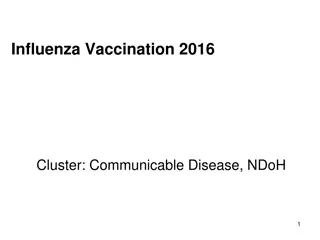The Power of Experiments: Learnings from Obama's Million Dollar Campaign
Businesses, governments, and campaigns like Obama's use experiments to make data-driven decisions. Discover how a simple experiment helped Obama raise $60 million, emphasizing the significance of randomized controlled experiments and real-world examples in optimizing outcomes.
Download Presentation

Please find below an Image/Link to download the presentation.
The content on the website is provided AS IS for your information and personal use only. It may not be sold, licensed, or shared on other websites without obtaining consent from the author.If you encounter any issues during the download, it is possible that the publisher has removed the file from their server.
You are allowed to download the files provided on this website for personal or commercial use, subject to the condition that they are used lawfully. All files are the property of their respective owners.
The content on the website is provided AS IS for your information and personal use only. It may not be sold, licensed, or shared on other websites without obtaining consent from the author.
E N D
Presentation Transcript
QM222 Nov. 13 Section A1 QM222 Nov. 13 Section A1 Experiments Experiments QM222 Fall 2017 Section A1 1
On presentations: Youll get link for signup today On presentations: You ll get link for signup today 5-10 minute presentations are graded only for preparing and giving them. I and your fellow students will give you suggestions and comments based on your presentation s content. My comments are NOT a substitute for my written comments. Presentations should include: A slide introducing your project: what the question is, making it clear who the recipient of the report is. A table of regression results with variables names that everyone can understand. (Text boxes etc. with key take- aways are useful here.) You could give >1 regression and can have additional tables or graphs. A conclusion. QM222 Fall 2017 Section A1 2
Randomized Controlled Experiments (RCT) Randomized Controlled Experiments (RCT) and Lab Experiments and Lab Experiments 1. Businesses use experiments to figure out what works Pricing experiments Marketing experiments Governments do policy experiments 2. Why? Because it is generally hard to be sure that you have identified causation in data analysis The Internet makes RCTs very simple to do. 3. QM222 Fall 2017 Section A1 3
Real Real- -world example: How Obama raised $60M world example: How Obama raised $60M by running a simple experiment by running a simple experiment Dan Siroker was working in Google in 2007, when he decided to join the campaign as Director of Analytics. His job was to use data to help the campaign make better decisions . His task was to maximize sign-ups for campaign emails QM222 Fall 2017 Section A1 4
How Obama raised $60 Million by running a How Obama raised $60 Million by running a Simple Experiment Simple Experiment The experiment tested two parts of the splash page: the Media section at the top and the call-to-action Button They tried four buttons and six different media (three images and three videos) 24 combinations. Every visitor to the splash page was randomly shown one of these 24 combinations. (Sometimes called A/B testing) Outcome they wanted to maximize: sign-up rate Number of Observations: 310,382 visitors to the splash page during the experiment that meant each variation was seen by roughly 13,000 people. http://blog.optimizely.com/2010/11/29/how-obama-raised-60-million-by- running-a-simple-experiment/ QM222 Fall 2017 Section A1 5
Here were the 4 buttons Here were the 4 buttons QM222 Fall 2017 Section A1 6
Here is one of the 24 combinations Here is one of the 24 combinations QM222 Fall 2017 Section A1 7
The Winner? The Winner? QM222 Fall 2017 Section A1 8
Here were their statistics Here were their statistics (averages with 95% confidence intervals) Rather than considering the 24 combinations Rather than considering the 24 combinations separately, this table separates out buttons and separately, this table separates out buttons and media media (averages with 95% confidence intervals) http://optimizely.wpengine.com/wp-content/uploads/2010/11/Obama_test_sections.jpeg QM222 Fall 2017 Section A1 9
Impact Impact The sign up rate for the winning design was 11.6% The sign up rate for the original design was 8.26% This would create a difference of 2,880,000 emails The average donation per email was $21 This translates into an additional $60M in donations QM222 Fall 2017 Section A1 10
Randomized Control Trials (RCTs) Randomized Control Trials (RCTs) In randomized experiments, people are randomly assigned to being in the treatment group or the control group. Randomly assigning people to a treatment is the most important dimension of an experiment. Random experiments are the GOLD STANDARD of research. QM222 Fall 2017 Section A1 11
Randomized Control Trials (RCTs) Randomized Control Trials (RCTs) Because assignment to the treatment group has nothing to do with the characteristics of the participants: on average participants in the treated group will be similar to those in the untreated group so we can be confident that the difference between the two groups is caused by the treatment. In other words, there is no selection bias The average level of potential confounding factors are the same on average QM222 Fall 2017 Section A1 12
In the Obama case, before they ran the experiment, the campaign staff heavily favored one of the videos, Sam s Video . Suppose they didn t run the experiment, but tried the Sam s video for a couple of weeks and saw a decrease in sign-up rates. Would that be convincing evidence that the original website was better? What are some examples of businesses who use A/B testing? QM222 Fall 2017 Section A1 13
Another marketing A/B example from Another marketing A/B example from Freakonomics podcast Freakonomics podcast A supermarket chain wanted to know which would induce people to buy more groceries when they visited the supermarket: a) Fast, lively music b) Slow, mellow music c) No music What kinds of things did they have to watch out for to make sure that this was truly randomly assigned? QM222 Fall 2017 Section A1 14
Lab experiments are ones done in a lab, not in the Lab experiments are ones done in a lab, not in the field field Last year, I did an experiment in class asking: Do Last year, I did an experiment in class asking: Do people learn better on paper or on a computer? people learn better on paper or on a computer? We gave people some GRE vocabulary definitions Half read them from a pdf Half had a piece of paper. Why did we need an experiment? How should we have assigned the paper v. computer roles? QM222 Fall 2017 Section A1 15
How did I use the results to figure out which How did I use the results to figure out which method was more successful? method was more successful? Regression Regression of course! of course! Run a regression of the outcome on a dummy variable for treatment. Why don t I need to control for other factors? How would controlling for other factors affect my estimated coefficient on treatment? QM222 Fall 2017 Section A1 16
Result of our experiment across both classes Result of our experiment across both classes Regression Statistics Multiple R 0.1990 R Square 0.03960 Adjusted R Sq 0.02275 Standard Error 1.0049 Observations 59 ANOVA df SS MS 2.37338 2.350337 0.130788 F Significance F Regression Residual Total 2.37337986 57 57.55882353 1.009804 58 59.93220339 1 Standard Error 0.1723 Lower 95% 6.8608 Upper 95% 7.5510 Coefficients 7.2059 t Stat 41.8127 P-value 0.0000 Intercept Treatment (Computer) -0.4059 0.2647 -1.5331 0.1308 -0.9360 0.1243 QM222 Fall 2017 Section A1 17
Another experiment: Labor Market Outcomes of Another experiment: Labor Market Outcomes of Immigrants to Canada Immigrants to Canada (from (from Oreopoulos Oreopoulos 2011) 2011) Recent immigrants to Canada struggle in the labor market. Unemployment rates are twice as high. Median wages of immigrants are 45% lower compared to native workers of the same education and experience levels In other words, if you run a regression of wages on immigrant status, education and experience (using a method that finds median not average) You find that immigrants have 45% lower salaries. Question: Can we conclude based on these numbers that there is discrimination against immigrants in Canada? QM222 Fall 2017 Section A1 18
Are we observing otherwise similar Are we observing otherwise similar immigrants and Canadian natives? NO! immigrants and Canadian natives? NO! Place of birth Canada Place of birth Colombia Education BA from McGill Education BA from Uniandes Language skills Perfect French and English Language skills Good English Little French Perfect Spanish Networks Strong Networks Weak Driven ? So, so Driven Very! Earnings $ 50K Earnings $ 35K QM222 Fall 2017 Section A1 19
The experiment The experiment Thousands of resumes were sent online in response to job postings across multiple occupations in Toronto after randomly varying characteristics on the resume to uncover what affects employer s decisions on whether to contact an applicant. The resumes were constructed to plausibly represent recent immigrants to Canada from the three largest countries of origin (China, India, and Pakistan) and from Britain, as well as non- immigrants with and without foreign-sounding names The author made different combinations of : where applicants received their undergraduate degree whether their job experience was gained in Canada or in their home country whether their name sounded foreign QM222 Fall 2017 Section A1 20
4 resumes were sent to each employer advertising 4 resumes were sent to each employer advertising a job over a 2 to 3 day period in random order a job over a 2 to 3 day period in random order Type 0: The first represented an applicant with an English sounding name, Canadian undergraduate education, and Canadian experience Type 1: Foreign sounding name, but still listed Canadian undergraduate education and Canadian experience Type 2: Foreign-sounding name, foreign undergraduate degree, and Canadian experience. Type 3: The fourth included a foreign-sounding name, foreign education, and some foreign experience. The outcome they looked at? Whether the employer called them back (for a telephone or face-to-face interview) QM222 Fall 2017 Section A1 21
How did they analyze the results? How did they analyze the results? Using regression, of course. But the ONLY variable you need is the indicator variable(s) for the treatment Which here means what type the application was. You do NOT need to control for anything else that might possibly confounding. Why? QM222 Fall 2017 Section A1 22
The author ran a regression on the different The author ran a regression on the different randomly chosen alternatives randomly chosen alternatives Call Back Rate = 0.160 0.045 Type1 - 0.045 Type2 - 0.085 Type3 (.040) (0.012) (0.015) (0.013) (se in parentheses) Type 0: The first represented an applicant with an English sounding name, Canadian undergraduate education, and Canadian experience Type 1: Foreign sounding name, but still listed Canadian undergraduate education and Canadian experience Type 2: Foreign-sounding name, foreign undergraduate degree, and Canadian experience. Type 3: The fourth included a foreign-sounding name, foreign education, and some foreign experience. Interpret each coefficient. Which types are significantly different from type 0? Are types 1, 2 and 3 significantly different from each other? What does all this say about discrimination against immigrants? QM222 Fall 2017 Section A1 23
URO experiments you might have taken URO experiments you might have taken In one experiment, we investigated the effects of labeling everyday consumption as addictive . For instance, the media will say that social media is addictive, that chocolate is addictive etc. but the actually, by definition, not addictive because there is no physiological basis. In the lab, we told subjects that products (M&M s, peas, carrots, the internet) were addictive or told them nothing and then watched them consume. We found that labeling something as addictive decreases people s perceived power over the situation and licenses them to eat/consume more. Summary: addictive labels on things that are not addictive make you consume more. This has public policy implications for labeling and communications. QM222 Fall 2017 Section A1 24
In one experiment, we gave students a specific motivation and asked questions about the purchase choices they would make. Any purchase can be pursued with a hedonic goal or a utilitarian goal. For example, a massage for pleasure (hedonic) or for treatment (utilitarian). A beer to drink for pleasure or to get drunk. A hotel for pleasure or business. We looked at differences in peoples preferences for these products when they pursued the same product using one motivation or the other. QM222 Fall 2017 Section A1 25
In another experiment, you imagined making a payment and reported your thoughts and feelings about the recipient of your payment. For example, you may have read scenarios about purchasing an umbrella and paying the business or having a meal and tipping the waiter. In these experiments, one half of the participants read about paying with cash, and the other half imagined paying with a card. The goal of this research was to see whether consumers feel more helpful when they pay in cash (rather than cards) and also to understand the psychological link between payment type and perceptions of that payment as helpful. Given that electronic payment forms are more prevalent, understanding the ramifications of this is important for both retailers and for consumers. QM222 Fall 2017 Section A1 26
In another study we looked at bragging on social media and how using an attachment cue that signals intrinsic motivation can lead people to perceive the braggart in a better light. For instance, people constantly post about their possession or brands these are often seen as a blatant brag and most people don t like braggarts. So if you post a picture on Instagram of your new LV handbag with the following: My new LV handbag isn t it fabulous! You are seen ad a braggart, people don t like you, and you are perceived more negatively than if you add an cue that signals personal attachment: My new LV handbag isn t it fabulous! I love it! QM222 Fall 2017 Section A1 27
A final example: Homework A final example: Homework We are interested on the effect of doing homework (X or treatment) on student s performance (Y or outcome). Suppose that I gather data at the end of regular QM222 and run the following regression: Final Grade = b0+ b1*Did homework What sign do you expect b1 to have? If b1 is negative, should I never assign homework? Can I interpret b1 as a causal effect? Why not? Problem: Self-selection into the treatment How could I make this into an RCT? QM222 Fall 2017 Section A1 28























